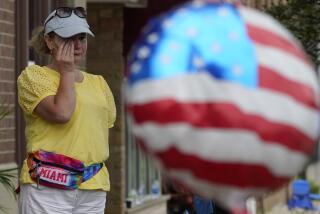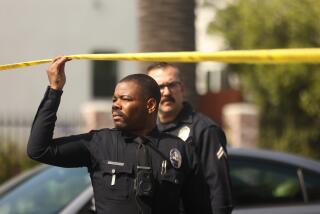Homicides in 1992 Set Record for L.A. County : Violence: 2,589 killings in 1992 represent an 8% rise over previous year. Cultural changes and accessibility of guns cited as factors.
Rocked by gang violence, civil unrest and a proliferation of lethal weapons, 1992 was the deadliest year in Los Angeles County history, officials said Monday.
Last year’s 2,589 homicides, based on a tally by the Los Angeles County coroner’s office, was up about 8% from the year before and represented enough slain people to fill the downtown Ahmanson Theatre to more than capacity.
Authorities, however, were not entirely surprised by the numbers, which had been foreshadowed by a summer so bloody it set records of its own, with 517 murders in July and August alone.
“I don’t know what accounts for it,” said coroner’s spokesman Scott Carrier. “We were optimistic things would subside when the (black) gangs called a truce, but that didn’t seem to happen.”
Among other things, authorities said, the toll reflects unprecedented mayhem in the city of Los Angeles--where 1,063 people were slain through Dec. 21. That figure was well above the total for 1991.
But criminologists say other, larger, factors are also at work, ranging from cultural changes that have broadened the opportunities for crime overall to the accessibility of guns.
“Yes, we have a lot of homicides,” said USC criminologist Marcus Felson. “But that’s been true for some time.”
Los Angeles County’s homicide rate generally has been on the rise for at least the past 20 years, statistics show. In 1970, the county had 10.2 homicides per 100,000 residents. By 1980, which for most of the decade stood as the county’s most violent year, the homicide rate was 24.4 killings per 100,000 residents.
For several years, the rate dipped, but it surged up again in 1991. Last year’s rate marked yet another record, 28 per 100,000 residents.
The numbers include not only the many people who are beaten, shot or stabbed to death, but those who die as the result of vehicular manslaughter. Gang violence is part of the story, but not as big a part as many suspect: According to LAPD statistics, for instance, only about a third of the city’s homicides this year were gang-related. The spring’s rioting played a part, contributing 52 deaths, but so, too, did hundreds of far-less-publicized slayings in homes and on streets countywide.
But Felson says there may be overarching trends as well--not the least of them the proliferation of guns.
“Homicide is just a fistfight when you have a gun in your fist,” Felson said. “There’s no indication that the person who, say, hits someone, is any less angry than the person who shoots someone. We just have much better weapons for people to grab when they’re angry than we used to.”
Additionally, Felson said, societal changes have opened broader opportunities for crime overall. Burglaries are much easier and more tempting now than they were a generation ago, for instance, because televisions, radios and other gadgets are so much lighter and easier to carry off. Women, too, are more at risk because they are dispersed in the job market, rather than congregated in neighborhoods, he said.
These and other factors, he said, helped boost the national crime rate by some 400% between the 1960s and the 1980s--a trend that was echoed in Los Angeles, and that police are continuing to study.
“It’s a little premature for us to analyze the numbers, but even without a full accounting for the number of murders in the city, they’re astronomical,” said Los Angeles Police Department Cmdr. David Gascon.
“What’s significant is that each of those numbers represents a human being,” Gascon said. “And numbers like that are clearly staggering.”
More to Read
Sign up for Essential California
The most important California stories and recommendations in your inbox every morning.
You may occasionally receive promotional content from the Los Angeles Times.










